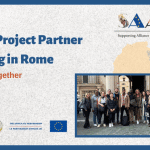Alfredo Garmendia and Estela Arkarazo (San Viator) and Béatrice Bellet (Mundus) were invited by the European External Action Service (EEAS) to explain the project SAAM and to talk about the importance of the implementation of education-related programmes to foster collaboration between Africa and Europe
On Tuesday, 31 January, Alfredo Garmendia and Estela Arkarazo (from San Viator, SAAM promoter) and Béatrice Bellet (from Mundus, SAAM coordinator) attended a meeting organised by the European External Action Service (EEAS) to explain the project SAAM together with Fr. Gildásio Dos Santos Mendez (General Counselor for the Social Communication of Don Bosco International) who presented the DBI activities in the field of vocational education and training in Africa.
The EEAS is the European Union’s diplomatic service and at the meeting representatives of education related departments of the European Commission were also present:
- DG EAC (Directorate-General of Education, Youth, Sport and Culture)
- DG INTPA (Directorate-General of International Partnerships)
- European Education and Culture Executive Agency (EACEA)
The conversation focused on the importance of the implementation of education-related programmes to foster collaboration between Africa and Europe. The SAAM project is paving the way in this intercontinental collaboration by implementing VET mobilities and good practices exchanges between both continents and therefore offered its expertise. The representatives of the entities that are promoting and coordinating the pilot project shared all the challenges that SAAM has encountered so far and provided recommendations and good practices to overcome them.
Since 2020 and despite the adverse conditions of the global pandemic, SAAM has managed to carry out more than 300 mobilities (students, professionals and experts from the SAAM team) and organize several international events both in Europe and in Africa. All these experiences have provided the SAAM partnership with great expertise in terms of administrative and logistical processes to achieve these mobilities. They have also witnessed the positive impact that these mobilities have both in European and African centers and are aware of the importance of this continuing after the end of the project.




